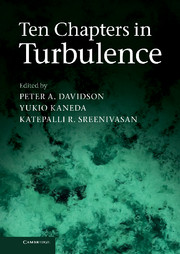Refine search
Actions for selected content:
8126 results in Fluid dynamics and solid mechanics

Earth Dynamics
- Deformations and Oscillations of the Rotating Earth
-
- Published online:
- 05 March 2013
- Print publication:
- 07 March 2013

Mesoscale-Convective Processes in the Atmosphere
-
- Published online:
- 05 March 2013
- Print publication:
- 25 March 2013
A TWO-STRAIN EPIDEMIC MODEL WITH UNCERTAINTY IN THE INTERACTION
-
- Journal:
- The ANZIAM Journal / Volume 54 / Issue 1-2 / October 2012
- Published online by Cambridge University Press:
- 21 February 2013, pp. 108-115
-
- Article
-
- You have access
- Export citation
TOPOLOGY OF STEADY HEAT CONDUCTION IN A SOLID SLAB SUBJECT TO A NONUNIFORM BOUNDARY CONDITION: THE CARSLAW–JAEGER SOLUTION REVISITED
-
- Journal:
- The ANZIAM Journal / Volume 53 / Issue 4 / April 2012
- Published online by Cambridge University Press:
- 18 February 2013, pp. 308-320
-
- Article
-
- You have access
- Export citation
AN ANALYTICAL AND NUMERICAL STUDY OF UNSTEADY CHANNEL FLOW WITH SLIP
-
- Journal:
- The ANZIAM Journal / Volume 53 / Issue 4 / April 2012
- Published online by Cambridge University Press:
- 08 February 2013, pp. 321-336
-
- Article
-
- You have access
- Export citation
SELECTIVE WITHDRAWAL OF A TWO-LAYER VISCOUS FLUID
-
- Journal:
- The ANZIAM Journal / Volume 53 / Issue 4 / April 2012
- Published online by Cambridge University Press:
- 08 February 2013, pp. 253-277
-
- Article
-
- You have access
- Export citation
OPTIMAL CONTROL OF SWITCHED IMPULSIVE SYSTEMS WITH TIME DELAY
-
- Journal:
- The ANZIAM Journal / Volume 53 / Issue 4 / April 2012
- Published online by Cambridge University Press:
- 07 February 2013, pp. 292-307
-
- Article
-
- You have access
- Export citation
A HYBRID MODEL FOR STUDYING SPATIAL ASPECTS OF INFECTIOUS DISEASES
- Part of
-
- Journal:
- The ANZIAM Journal / Volume 54 / Issue 1-2 / October 2012
- Published online by Cambridge University Press:
- 07 February 2013, pp. 37-49
-
- Article
-
- You have access
- Export citation

Ten Chapters in Turbulence
-
- Published online:
- 05 February 2013
- Print publication:
- 06 December 2012
LIFE HISTORIES OFFER A CLUE TO THE FUTURE OF INFECTIOUS DISEASE ON CORAL REEFS
-
- Journal:
- The ANZIAM Journal / Volume 54 / Issue 1-2 / October 2012
- Published online by Cambridge University Press:
- 04 February 2013, pp. 64-73
-
- Article
-
- You have access
- Export citation
EPIDEMIC DYNAMICS ON RANDOM AND SCALE-FREE NETWORKS
-
- Journal:
- The ANZIAM Journal / Volume 54 / Issue 1-2 / October 2012
- Published online by Cambridge University Press:
- 30 January 2013, pp. 3-22
-
- Article
-
- You have access
- Export citation
9 - MHD Dynamos and Turbulence
-
-
- Book:
- Ten Chapters in Turbulence
- Published online:
- 05 February 2013
- Print publication:
- 06 December 2012, pp 351-404
-
- Chapter
- Export citation
Frontmatter
-
- Book:
- Ten Chapters in Turbulence
- Published online:
- 05 February 2013
- Print publication:
- 06 December 2012, pp i-iv
-
- Chapter
- Export citation
Contributors
-
- Book:
- Ten Chapters in Turbulence
- Published online:
- 05 February 2013
- Print publication:
- 06 December 2012, pp xi-xii
-
- Chapter
- Export citation
6 - Dynamics of Wall-Bounded Turbulence
-
-
- Book:
- Ten Chapters in Turbulence
- Published online:
- 05 February 2013
- Print publication:
- 06 December 2012, pp 221-268
-
- Chapter
- Export citation
7 - Recent Progress in Stratified Turbulence
-
-
- Book:
- Ten Chapters in Turbulence
- Published online:
- 05 February 2013
- Print publication:
- 06 December 2012, pp 269-317
-
- Chapter
- Export citation
2 - Structure and Dynamics of Vorticity in Turbulence
-
-
- Book:
- Ten Chapters in Turbulence
- Published online:
- 05 February 2013
- Print publication:
- 06 December 2012, pp 43-86
-
- Chapter
- Export citation
5 - The Eddies and Scales of Wall Turbulence
-
-
- Book:
- Ten Chapters in Turbulence
- Published online:
- 05 February 2013
- Print publication:
- 06 December 2012, pp 176-220
-
- Chapter
- Export citation
1 - Small-Scale Statistics and Structure of Turbulence – in the Light of High Resolution Direct Numerical Simulation
-
-
- Book:
- Ten Chapters in Turbulence
- Published online:
- 05 February 2013
- Print publication:
- 06 December 2012, pp 1-42
-
- Chapter
- Export citation
4 - A Lagrangian View of Turbulent Dispersion and Mixing
-
-
- Book:
- Ten Chapters in Turbulence
- Published online:
- 05 February 2013
- Print publication:
- 06 December 2012, pp 132-175
-
- Chapter
- Export citation






